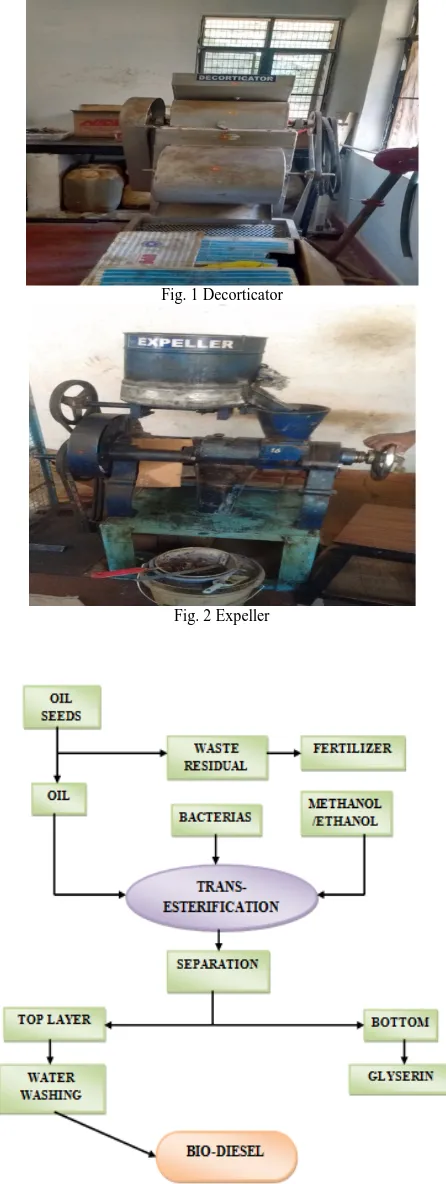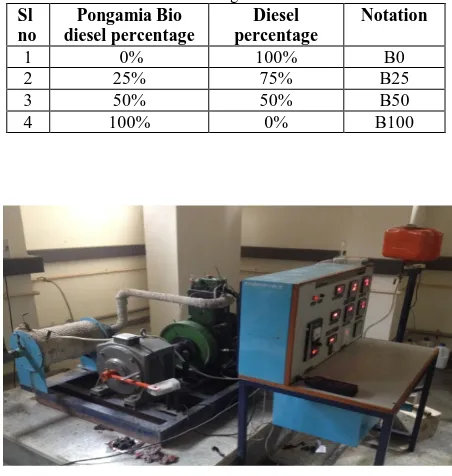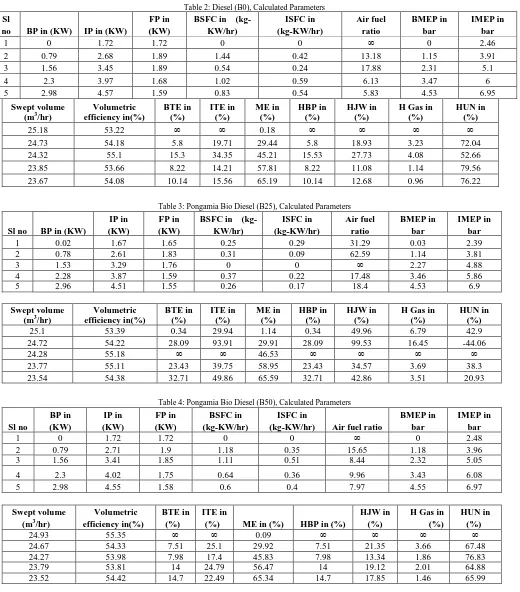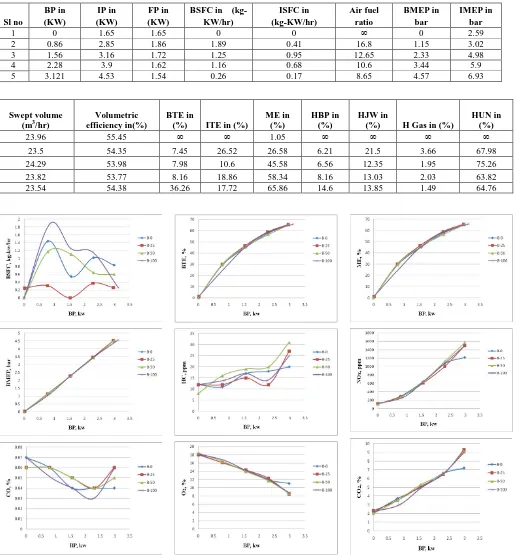ISSN 2348 – 7968
Performance and Emission Characteristics of 4 Stroke Single
Cylinder Diesel Engine Using Pongamia Bio Diesel Blends With
Diesel
Mahesh babu CP#1
P
, Nagendra prasad SP
*2
P
, Shwetha CP
#3,
P
Chaithra M CP
#4
P
, Balasubramaniam N SP
#5
P
#1,2,3,4
P
Student, Department of Mechanical Engineering, C.B.I.T., Kolar, Karnataka, India
P
5
P
Asst Professor, Department of Mechanical Engineering, C.B.I.T., Kolar, Karnataka, India
30TU
maheshm2606@gmail.comU30T
30TU
nagendraprasad2392@gmail.comU30T
30TU
ammu.shwetha92@gmail.comU30T
Chaithrachinnu970@gmail.com
30TU
balu_me400@rediffmail.comU30T
31T
Abstract
In current scenario, there are continuously increasing the number of automobiles and correspondingly increasing the fuel consumption as well as fuel prices. Many researches are looking forward to find an alternative source of renewable energy. One such alternative to diesel fuel is bio diesel. Bio diesel can be defined as fuel comprising of mano alkyl ester of long chain of fatty acid derived from PONGAMIA. The paper will discuss the use of diesel with PONGAMIA bio diesel blends in four stroke diesel engine. This alternative fuel contains, PONGAMIA bio diesel is blended with diesel. The scope of the project is to investigate the effect of injection pressures on a blend of 25%, 50%, and 100% of pongamia bio diesel with DIESEL and compare with pure DIESEL on the study of performance and emission characteristics of the diesel engine. Four tested fuels were used during experiment like 100% diesel and a blend of 25%, 50%, 100% PONGAMIA biodiesel mixing in the diesel. For those mixtures the brake specific fuel consumption (BSFC), mechanical efficiency, brake thermal efficiency, mean effective pressure are calculated. The gas emissions of oxides of nitrogen (NOX), carbon-di-oxide (CO2), carbon-mono –oxide (CO), hydro carbons (HC) are being measured by the use of AVL smoke meter. The performance test was conducted at constant speed with variable load. The experimental work is conducted on four stroke single cylinder water cooled diesel engine.
31T
Keywords31T— Pongamia oil, Bio diesel and diesel.
1. Introduction
India is one of the fastest developing countries with a stable economic growth. Fuel consumption is directly proportionate to the demand. India has maintained a high growth rate in accepting the improved technological challenges in global scenario. India depends mainly on imported fuels due to lack of fossil fuels reserves and it has a great impact on economy. India has to look for an alternative for alternative fuels in order to sustain the growth rate. India is home to 1.2 billion people, who are about, 17% of world population, and its thirst for energy is unquenchable. India ranks sixth in the world in
terms of energy demand accounting for 3.5% of world commercial energy demand in 2001. The energy demand is expected to grow at 4.8%. The demand of diesel is projected to grow from 39.81 million metric tons in 2001 – 02 to 52.32 million metric tons in 2006 – 07 @ 5.5% per annum. Also due to gradual depletion of the world petroleum reserve, rising petroleum prices, increasing threat to the environment from exhaust emission and global warming have generated an intense international interest in developing alternative non petroleum fuels. India produces about 826,000 barrels of oil per day and requires about 3,319,000 barrels of oil per day (2010) (statistical review of world energy, 2011).
The idea of using vegetable oil as fuel for diesel engines is not a new one. Rudolph Diesel used peanut oil as fuel in his engine at Paris Exposition of 1900. In spite of the technical feasibility, vegetable oil as fuel could not get acceptance, as it was more expensive than petroleum fuels. Later various factors as stated earlier, renewed the interests of researchers in using vegetable oil as substitute fuel for diesel engines. In recent years, systematic efforts have been made by several researchers to use vegetable oils of Sunflower, Peanut, Soya bean, Rapeseed, Olive, Cottonseed, Jatropha, Pongamia, Rubber seed, etc as alternate fuel for diesel. Many types of vegetable oils are edible in nature. Continuous use of them causes shortage of food supply and proves far expensive to be used as fuel at present. So far few types of non-edible vegetable oils have been tried on diesel engine leaving a lot of scope in this area.
Testing of diesel engines with preheating, blending with diesel and blending with preheating improves the performance and reduces the emissions compared to neat vegetable oil. Biodiesel is produced by Trans-esterification of oil, where one mole of oil is chemically reacted with three moles of an alcohol in presence of a catalyst.
Biodiesel has others advantages, compared to conventional diesel fuel, such as: portability, ready availability, renewability, biodegradability, lower sulphur content, higher Cetane number, flash point, cloud point and cold filter plugging point.
2. Methodology
Bio diesel production is the process of producing the bio fuel, bio diesel through the chemical reactions esterification and Trans-esterification. This involves vegetable or animal fats and oils being reacted with short chain alcohols (typically methanol or ethanol). The alcohols used should be of low molecular weight being one of the most used ethanol for its low cost. However, greater conversions into bio diesel can be reached using methanol.
Trans-esterification is the process of exchanging the organic group R” of an ester with the organic group R’ of an alcohol .These reactions are often catalysed by the addition of an acid or base catalyst.
The act of stripping the hulls of the seeds is known as decorticating. Decorticators are also known as shell removers or separators. Decorticators are an integral part of the oil mill plant and they are specially made to crack the outer shell of the groundnuts. Shelling a large number of these nuts is laborious task and consumes a lot of time. In order to make shelling process of ground nuts easier, the decorticator machine is designed and developed for handling the different process applications in the oil mill plant and oil mill operation.
The main function of this machine is to perform the task of cracking the shell of seeds as well as separate the inside kernel which is the part of seed, from the shell. Decorticator machine consists of hardened knives for efficient performance. It helps in increasing the purity and quality of the seeds, which then further increase the quality of the oil that is extracted from these seeds. These machines are used for cleaning all sorts of seeds such as karanja, Jatropha, cotton seeds etc.
Oil expeller is the central part of the whole oil extraction plant. Oil expeller consists of a screw shaped worm enclosed in a sealed chamber. The chamber has inlet and outlet opening which enable the flow of input seeds and outgoing oil and refuse. The precooked seeds are fed through a hopper into the inlet of the chamber. The screwing action of the worm pushes the seeds towards the narrow end. As the seeds are pressed to the narrow end, Oil is released as a result of increased pressure through very tiny holes, specially built at this end, oil escapes the chamber flowing through the pipes oil is collected at storage end. The refuse of the seeds after extracting oil is collected as oil cakes which is again a very important
commercial product. Most of the plants work out their economic viability by calculating the sales of oil cakes.
Fig. 1 Decorticator
Fig. 2 Expeller
Fig. 3 Block diagram representation of production of Bio-Diesel
Production of Bio Diesel:
• Measure 1 liter of oil.
• Transfer this oil into a 3-neck flask provided as part of the laboratory set.
• Place the 3-neck flask on magnetic stirrer. • Put the magnet pellet into the flask
• Fix the reflex condenser to the central neck of 3-neck flask. Please connect the water pipe line to the condenser and check up for water circulation from the tap to condenser and outlet.
• Connect the magnetic stirrer to electrical connection. • Switch on the magnetic stirrer switch.
• Set up the heating control to 60 P
0
P
c.
• Adjust the speed between 600-800 rpm to get a homogenous/uniform heating of the oil.
• Take the glass thermo-well and add some oil into the thermo-well. Insert the thermo-well into the side neck of the 3-neck flask. Place the thermometer into the thermo-well and check the temperature.
• Take 300ml methanol per liter of oil in a 500ml capacity beaker.
• Weigh the required NaOH based on the FFA% determined earlier for the raw oil (i.e. for zero) FFA 3.5gms of NaOH and add to methanol. Stir well and the produced mixture is called “Methoxide” mixture.
• When the temperature reaches 63P
0
P
C, add the methoxide mixture slowly to the hot oil into oil into the 3-neck flask through the loading opening neck and maintain the speed at 600 rpm. Close the opening with a stopper.
• Maintain the temp at 60P
0
P
C to 63P
0
P
C (total reaction time is 2 hours).
• Run the process for 30 minutes and observe the color of the mixture turns from turbid orange to transparent chilly red ( in the reaction vessel)
• After the first 30 minutes drain a sample and allow it to settle. Two distinct layer will be obtained indicating of the chemical reaction is proceeding in the right direction. The bottom layer is glycerin.
• Run the process for another 1 P
1/2
P
hour.
• After 1 ½ hour, drain one more sample and observe for glycerin separation. Then switch off the power and remove the reflux condenser.
• Transfer the mixture into a separating funnel and allow to settle for 2 hours.
• After 2 hours, glycerin will settle at the bottom and bio-diesel separates as top layer.
• Drain the glycerin layer from the separating funnel from the bottom carefully and store it.
• Allow the bio diesel layer to settle for another ½ hour and observe if any further glycerin content settles. If glycerin layer is seen, then drain the same.
By using Parry’s engine Brake power (B.P), Frictional power (F.P), Indicated power (I.P), Mechanical
efficiency (ηRmechR), Mean effective pressure (PRmR) Indicated
mean effective pressure, Brake mean effective pressure, Frictional mean effective pressure, Volumetric efficiency (ƞRvolR), Fuel-air ratio (f/a ratio), Air–fuel ratio(a/f ratio),
Specific fuel consumption (S.F.C), Brake specific fuel consumption (B.S.F.C), Heat input, Thermal efficiency(ƞRthermalR), Indicated thermal efficiency(ƞRitheR), Brake
thermal efficiency(ƞRbtheR).
Table 1: The blending of biodiesel with diesel
Sl no
Pongamia Bio diesel percentage
Diesel percentage
Notation
1 0% 100% B0
2 25% 75% B25
3 50% 50% B50
4 100% 0% B100
Fig. 3 Experimental setup of Parry’s test engine
3. Results and Discussion
Table 2: Diesel (B0), Calculated Parameters
Sl
no BP in (KW) IP in (KW)
FP in (KW)
BSFC in (kg-KW/hr) ISFC in (kg-KW/hr) Air fuel ratio BMEP in bar IMEP in bar
1 0 1.72 1.72 0 0 ∞ 0 2.46
2 0.79 2.68 1.89 1.44 0.42 13.18 1.15 3.91
3 1.56 3.45 1.89 0.54 0.24 17.88 2.31 5.1
4 2.3 3.97 1.68 1.02 0.59 6.13 3.47 6
5 2.98 4.57 1.59 0.83 0.54 5.83 4.53 6.95
Swept volume (mP 3 P /hr) Volumetric efficiency in(%) BTE in (%) ITE in (%) ME in (%) HBP in (%) HJW in (%)
H Gas in (%)
HUN in (%)
25.18 53.22 ∞ ∞ 0.18 ∞ ∞ ∞ ∞
24.73 54.18 5.8 19.71 29.44 5.8 18.93 3.23 72.04
24.32 55.1 15.3 34.35 45.21 15.53 27.73 4.08 52.66 23.85 53.66 8.22 14.21 57.81 8.22 11.08 1.14 79.56 23.67 54.08 10.14 15.56 65.19 10.14 12.68 0.96 76.22
Table 3: Pongamia Bio Diesel (B25), Calculated Parameters
Sl no BP in (KW)
IP in (KW)
FP in (KW)
BSFC in (kg-KW/hr) ISFC in (kg-KW/hr) Air fuel ratio BMEP in bar IMEP in bar
1 0.02 1.67 1.65 0.25 0.29 31.29 0.03 2.39
2 0.78 2.61 1.83 0.31 0.09 62.59 1.14 3.81
3 1.53 3.29 1.76 0 0 ∞ 2.27 4.88
4 2.28 3.87 1.59 0.37 0.22 17.48 3.46 5.86
5 2.96 4.51 1.55 0.26 0.17 18.4 4.53 6.9
Swept volume (mP 3 P /hr) Volumetric efficiency in(%) BTE in (%) ITE in (%) ME in (%) HBP in (%) HJW in (%)
H Gas in (%)
HUN in (%)
25.1 53.39 0.34 29.94 1.14 0.34 49.96 6.79 42.9
24.72 54.22 28.09 93.91 29.91 28.09 99.53 16.45 -44.06
24.28 55.18 ∞ ∞ 46.53 ∞ ∞ ∞ ∞
23.77 55.11 23.43 39.75 58.95 23.43 34.57 3.69 38.3 23.54 54.38 32.71 49.86 65.59 32.71 42.86 3.51 20.93
Table 4: Pongamia Bio Diesel (B50), Calculated Parameters
Sl no BP in (KW) IP in (KW) FP in (KW) BSFC in (kg-KW/hr) ISFC in
(kg-KW/hr) Air fuel ratio
BMEP in bar
IMEP in bar
1 0 1.72 1.72 0 0 ∞ 0 2.48
2 0.79 2.71 1.9 1.18 0.35 15.65 1.18 3.96
3 1.56 3.41 1.85 1.11 0.51 8.44 2.32 5.05
4 2.3 4.02 1.75 0.64 0.36 9.96 3.43 6.08
5 2.98 4.55 1.58 0.6 0.4 7.97 4.55 6.97
Swept volume (mP 3 P /hr) Volumetric efficiency in(%) BTE in (%) ITE in
(%) ME in (%) HBP in (%)
HJW in (%)
H Gas in (%)
HUN in (%)
24.93 55.35 ∞ ∞ 0.09 ∞ ∞ ∞ ∞
24.67 54.33 7.51 25.1 29.92 7.51 21.35 3.66 67.48 24.27 53.98 7.98 17.4 45.83 7.98 13.34 1.86 76.83
23.79 53.81 14 24.79 56.47 14 19.12 2.01 64.88
23.52 54.42 14.7 22.49 65.34 14.7 17.85 1.46 65.99
Table 5: Pongamia Biodiesel (B80), Calculated Parameters
Sl no
BP in (KW)
IP in (KW)
FP in (KW)
BSFC in (kg-KW/hr)
ISFC in (kg-KW/hr)
Air fuel ratio
BMEP in bar
IMEP in bar
1 0 1.65 1.65 0 0 ∞ 0 2.59
2 0.86 2.85 1.86 1.89 0.41 16.8 1.15 3.02
3 1.56 3.16 1.72 1.25 0.95 12.65 2.33 4.98
4 2.28 3.9 1.62 1.16 0.68 10.6 3.44 5.9
5 3.121 4.53 1.54 0.26 0.17 8.65 4.57 6.93
Swept volume (mP
3
P
/hr)
Volumetric efficiency in(%)
BTE in
(%) ITE in (%)
ME in (%)
HBP in (%)
HJW in
(%) H Gas in (%)
HUN in (%)
23.96 55.45 ∞ ∞ 1.05 ∞ ∞ ∞ ∞
23.5 54.35 7.45 26.52 26.58 6.21 21.5 3.66 67.98
24.29 53.98 7.98 10.6 45.58 6.56 12.35 1.95 75.26
23.82 53.77 8.16 18.86 58.34 8.16 13.03 2.03 63.82
23.54 54.38 36.26 17.72 65.86 14.6 13.85 1.49 64.76
Fig. 4 Graphs on Performance and Emission Characteristics of Pongamia Bio Diesel
4. Conclusion
Demand for transport fuel is increasing unabatedly in India. On the other hand there are frequent hikes of prices of fossil fuel and uncertain supply in international market. To minimize the import of crude oil we must go for Bio fuels which are renewable and eco friendly. Pongamia oil may stands as Biodiesel which is renewable, safe and non-polluting. It holds great promise to the rural sectors of India to meet the energy and organic fertilizer requirements. Of course researchers are to be carried out on Pongamia to standardize agro-technology, low cost and efficient mechanical device to expel oil, to find out the economics, high yielding and high oil content varieties suitable to the different agro-climates of India. In that way researchers are also to be carried out value addition on by products of Pongamia oil. By planting Pongamia on roadsides, river bank, on the two sides of irrigation canals, marginal and degraded soils. India will able to produce tons of Bio-diesel and organic fertilizers (Oilcake) in near future.
5. References
[1] P Gogoi, “Assam, Pongamia Oil—A Promising Source of Bio-Diesel,” Assam University Press, Assam, 2008.
[2] Leung D.Y.C, Wu X, Leung M.K.H.,A review on biodiesel production using catalyzed trans-esterification, Applied Energy, 2010, 87, 1083–1095
[3] Chen H, Peng B, Wang D and Wang J., Biodiesel production by the trans-esterification of cottonseed oil by solid acid catalysts, Front. Chem. Eng China, 2007, 1, 11-15.
[4]V. Kesari, A. Das and L. Rangan, “Physico-Chemical Characterization and Antimicrobial Activity from Seed Oil of Pongamia Pinnata a Potential Biofuel Crop,” Bio Mass and Bio Energy, Vol. 34, No. 1, 2010, pp. 108-115. Udoi:org/10.1016/j.biombioe.2009.10.006
[5] S. Sangwan, D. V. Rao and R. A. Sharma, “A Review on Pongamia Pinnata (L.) Pierre: A Great Versatile Legu-minous Plant,” Nature and Science, Vol. 8, 2010, pp. 1 -11.
[6]N. Mukta, Y. Sreevalli, “Propagation Techniques, Eva- luation and Improvement of the Biodiesel Plant, Pongamia pinnata (L.) Pierre—A Review,” Industrial Crops and Products, Vol. 31, No. 1, 2010, pp. 1-12.
[7] W. S. Eipesona, J. R. Manjunathab, P. Srinivasb and T. C. S. Kanya, “Extraction and Recovery of Karanjin: A Value Addition to Karanja (Pongamia Pinnata) Seed Oil,” In-dustrial Crops and Products, Vol. 32, No. 2, 2010, pp. 118-1



